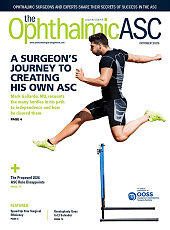Remote patient monitoring (RPM) is one of the fastest-growing segments in medicine, with average Medicare spending on RPM skyrocketing from $6.8 million in 2019 to $194.5 in 2023.1
Home-based monitoring, the most common form of RPM, not only reduces the burden on patients but also allows remote disease surveillance by their physicians, enabling treatments to be aligned with disease progression rather than a pre-specified clinic visit schedule. Use of home monitoring has shown improved management of blood pressure in patients suffering from hypertension.1 Is it possible to achieve similarly positive outcomes in ophthalmology?
The answer is yes, particularly in the management of retinal diseases. Home-based functional testing, known as preferential hyperacuity perimetry (PHP) (ForeseeHome, Notal Vision), has resulted in excellent outcomes for patients with age-related macular degeneration (AMD). In the Home-Monitoring and Education (HOME) study, a randomized controlled trial within the larger Age-Related Eye Disease Studies (AREDS2), intermediate AMD patients who used ForeseeHome had a presenting visual acuity that was 5 letters better at the time of conversion to wet AMD as compared to those who received standard monitoring with an Amsler grid.2 The performance was also substantiated in a real-world study,3 further demonstrating the effectiveness of home monitoring for management of AMD, one of the leading causes of irreversible vision loss in the United States.
KEY TAKEAWAYS
- Home-based monitoring improves care by reducing patient burden and allowing proactive treatment adjustments.
- The HOME/AREDS2 study showed that remote patient monitoring improved early detection of wet AMD.
- Remote patient monitoring creates recurring revenue without needing in-clinic resources or equipment.
In addition to these promising results, interest in retinal disease home monitoring has increased with the FDA approval of the first-ever home-based optical coherence tomography (OCT) device: the SCANLY Home OCT (Notal Vision). This device brings in-office technology into the patient’s home with the ability to quantitatively monitor AMD-related intraretinal and subretinal hypo-reflective spaces (equivalent to intraretinal/subretinal fluid) over time, alerting monitoring physicians when specific quantitative thresholds are exceeded.4,5
Workflow Challenges
Despite these positive advancements, apprehension about the impact of home-monitoring services on retina clinics remains. It comes down to 2 concerns: the burden on the practice in providing home monitoring and the overall impact on the practice’s revenue.
How can a busy retina clinic manage the additional burden of supporting home monitoring services? What about patient education, device-related training and support, and ensuring adherence to the program?
These are valid concerns. To date, we have been able to navigate these issues by leveraging the assistance of external home monitoring providers. In essence, a successful remote monitoring paradigm relies on not just placing a device in a patient’s home, but rather on forming a close partnership with an RPM service provider. Such partners supply the devices and manage tasks including patient education, support, and adherence monitoring. Real-world data has shown that this support model improves patient adherence.3 By outsourcing device management and monitoring, the practice can focus on the patient care aspect of RPM in AMD. The workflow for the practice thus involves only submitting a referral prescription, responding to any monitoring alerts, and billing for the services performed.
Practice Revenue
Billing and reimbursement-related concerns are just as significant to practices as the workflow challenges previously discussed. In remote monitoring services across various medical specialties, RPM reimbursement is typically divided into procedural codes representing setup, device monitoring, and data review. The monitoring service provider typically bills for the setup and device monitoring components, covering the cost of hardware and infrastructure. The practice then bills for professional services, including data interpretation and reporting. For example, home OCT service has 3 associated codes: 0604T (setup), 0605T (monitoring), and 0606T (data review).
The professional component drives practice revenue. This code is set up to be billed every 30 days for a given patient, for the cumulative work performed in that period. So, once a patient is in the program, it creates a recurring revenue opportunity every 30 days. The professional component is billed for one or more data reviews that are performed and documented during the billing cycle period. Note that billing for remote services is separate from billing for services provided during an in-office encounter.
Revenue generation through such remote work may allow for greater practice productivity as it is not constrained by the physical requirements of specialized instrumentation and the presence of specific personnel at a given location.
The Broader Impact on Patient Flow
While home monitoring has the potential to offer a favorable return—via added revenue without the need to invest in new devices or therapeutics—it may also influence patient visit patterns and other revenue streams tied to in-office OCT imaging. The impact of this new technology will vary depending on local practice patterns, but there are general trends and considerations that can help inform these evaluations.
Increasing Capacity for New Patients
Over the last decade, retina practices have faced ever-increasing patient volumes due to the expanding population of older adults who require regular monitoring and treatment for age-related eye conditions. The need for frequent follow-up visits among existing patients can constrain physicians’ capacity to accommodate new patients, creating ongoing challenges in balancing care delivery. If the interval between patient visits can be increased without affecting visual outcomes, it should allow more patients to be introduced into the pipeline. This is especially relevant for retina specialists managing patients with geographic atrophy, who may now require newly approved intravitreal therapies every 4-8 weeks. Adding this new subset of patients can place a critical strain on clinic capacity.
Home monitoring may be one way to help manage this strain via its potential to increase the interval between visits for patients treated for neovascular AMD (NVAMD). One recent study found that home OCT could reduce visit frequency by nearly 48% for NVAMD patients.6 If such results are even partially realized in a real-world setting, it would create immense potential for retina practices to optimize their time while having a larger overall patient base.
Increased Retention of Patients
Patient retention is also a major problem, particularly for a disease in which patients need frequent indefinite treatments. A recent study showed nearly 38% of NVAMD patients discontinue care after 2 years.7 This patient attrition is likely a major factor in the worse visual outcomes seen in the real-world as compared to clinical trials. Home monitoring may allow for safe and more rapid extension of treatment intervals, thereby improving compliance by reducing visit burden. It also provides an ongoing digital connection between patients and practices. Any reduction in home monitoring frequency is detected by the monitoring center, and the patient is contacted. This serves as a reminder to patients about the importance of their ocular disease and the need for continued regular follow-up.
Increased Patient Satisfaction
Chronic ocular diseases impose a significant burden on patients and caregivers. One global study estimated that the well-being cost incurred due to increased depression and anxiety from NVAMD treatments exceeded the direct medical costs.8 Home monitoring can help reduce these negative psychological consequences by giving patients a sense of control and reassurance through continuous oversight. It provides peace of mind as their disease is being closely monitored while also reducing office visit-associated stress due to the anticipated reduction in visit frequency. The data so far show high satisfaction among patients using such tools. By offering such technology, a practice stands to differentiate itself from others and score high in terms of overall patient satisfaction.
Conclusion
To summarize, expansion of remote monitoring in ophthalmology appears inevitable. Early adopting practices stand to benefit by way of improved clinic volumes and enhanced patient value resulting from more productive and efficient care delivery. However, based on remote monitoring experiences from other fields, it is clear that utilizing a third-party partner to provide patient support and device monitoring will be key to successful deployment. Such services promise to bring ophthalmic practices into the digital age and may ultimately provide a strategic asset to help practices grow beyond their current manpower-related limitations. OM
References
- Evolving Remote Monitoring: An Evidence-Based Approach to Coverage and Payment. Peterson Center on Healthcare. April 2025.
- AREDS2-HOME Study Research Group, Chew EY, Clemons TE, et al. Randomized trial of a home monitoring system for early detection of choroidal neovascularization home monitoring of the Eye (HOME) study. Ophthalmology. 2014;121(2):535-544. doi:10.1016/j.ophtha.2013.10.027
- Mathai M, Reddy S, Elman MJ, et al. Analysis of the Long-term Visual Outcomes of ForeseeHome Remote Telemonitoring: The ALOFT Study. Ophthalmol Retina. 2022;6(10):922-929. doi:10.1016/j.oret.2022.04.016
- Heier JS, Holekamp NM, Busquets MA, et al. Pivotal Trial Validating Usability and Visualization Performance of Home OCT in Neovascular Age-Related Macular Degeneration: Report 1. Ophthalmol Sci. 2025;5(5):100772. Published 2025 Mar 21. doi:10.1016/j.xops.2025.100772
- Ahn SJ. Retinal Thickness Analysis Using Optical Coherence Tomography: Diagnostic and Monitoring Applications in Retinal Diseases. Diagnostics (Basel). 2025;15(7):833. Published 2025 Mar 25. doi:10.3390/diagnostics15070833
- Holekamp NM, de Beus AM, Clark WL, Heier JS. Prospective trial of home optical coherence tomography-guided management of treatment experienced neovascular age-related macular degeneration patients. Retina. 2024;44(10):1714-1731. doi:10.1097/IAE.0000000000004167
- Wykoff Charles C, Garmo V, Tabano D, et al. Impact of Anti-VEGF Treatment and Patient Characteristics on Vision Outcomes in Neovascular Age-related Macular Degeneration: Up to 6-Year Analysis of the AAO IRIS® Registry. Ophthalmol Sci. 2023;4(2):100421. Published 2023 Oct 31. doi:10.1016/j.xops.2023.100421
- Spooner KL, Mhlanga CT, Hong TH, Broadhead GK, Chang AA. The burden of neovascular age-related macular degeneration: a patient's perspective. Clin Ophthalmol. 2018;12:2483-2491. Published 2018 Dec 4. doi:10.2147/OPTH.S185052









